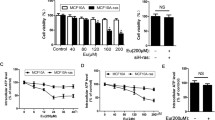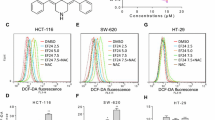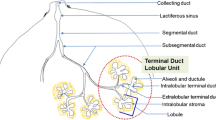Abstract
Curcumin, a dietary pigment in turmeric, posseses anti-carcinogenic and anti-metastatic properties. The present study was conducted to studyin vitro chemopreventive effects of curcumin in transformed breast cells. Here, we show that curcumin inhibits H-ras-induced invasive phenotype in MCF10A human breast epithelial cells (H-ras MCF10A) and downregulates matrix metalloproteinase (MMP)-2 dose-dependently. Curcumin exerted cytotoxic effect on H-ras MCF10A cells in a concentration-dependent manner. Curcumin-induced cell death was mainly due to apoptosis in which a prominent downregulation of Bcl-2 and upregulation of Bax were involved. We also suggest a possible involvement of caspase-3 in curcumin-induced apoptosis. Curcumin treatment resulted in the production of reactive oxygen species (ROS) in H-ras MCF10A cells. Apoptotic event by curcumin was significantly inhibited by pretreatment of an antioxidantN-acetyl-1-cysteine (NAC), suggesting redox signaling as a mechanism responsible for curcumin-induced apoptosis in H-ras MCF10A cells. Taken together, our results demonstrate that curcumin inhibits invasion and induces apoptosis, proving the chemopreventive potential of curcumin.
Similar content being viewed by others
References
Alnemri, E. S., Mammalian cell death protease: a family of highly conserved aspartate specific cytosine proteases.J. Cell Biochem., 64, 33–42 (1997).
Anjum, R. and Khar, A., Differential regulation of apoptosis in AK-5 tumor cells by the proto-oncogene Bcl-2: presence of Bcl-2 dependent and independent pathways.FEBS Lett., 499, 166–70 (2001).
Bass, D. A., Parce, J. W., Dechatelet, L. R., Szejda, P., Seeds, M. C., and Thomas, M., Flow cytometric studies of oxidative product formation by neutrophils: a graded response to membrane stimulation.J. Immunol., 130 (4), 1910–7 (1983).
Bae, Y. S., Kang, S. W., Seo, M. S., Baines, I. C., Tekle, E., Chock, P. B., and Rhee, S. C., Epidermal growth factor (EGF)-induced generation of hydrogen peroxide. Role in EGF receptor-mediated tyrosine phosphorylation.J. Biol. Chem., 272(1), 217–21 (1997).
Bernhard, E. J., Cruber, S. B., and Muschel, R. J., Direct evidence linking expression of matrix metalloproteinase 9 (92-kDa gelatinase/ collagenase) to the metastatic phenotype in transformed rat embryo cells.Proc. Natl. Acad. Sci., 91, 4293–7 (1994).
Bhaumik, S., Anjum, R., Rangaraj, N., Pardhasaradhi, B. V., and Khar, A., Curcumin mediated apoptosis in AK-5 tumor cells involves the production of reactive oxygen intermediates.FEBS Lett., 456, 311–4 (1999).
Chun, K. -S., Shon, Y., Kim, H. -S., Kim, O. H., Park, K.- K., Lee, J. -M., Lee, J., Lee, J. -Y., Moon, A., Lee, S. S., and Surh, Y -J., Anti-tumor promoting potential of naturally occurring diarylheptanoids structurally related to curcumin.Mutat. Res., 428, 49–57 (1999).
Cooper, J. D., Michaelidis, T. M., Tzimagiorgis, G. Z., Sendtner, M., Meyer, M., and Thoenen, H., Cholinergic neuron-specific overexpression of Bax in ChAT Bax transgenic mice.Soc. Neurosci. Abstr., 22, 570 (1996).
Dorai, T., Cao, Y. C., Dorai, B., Buttyan, R., and Katz, A. E., Therapeutic potential of curcumin in human prostate cancer. III. Curcumin inhibits proliferation, induces apoptosis, and inhibits angiogenesis of LNCaP prostate cancer cells in vivo.Prostate, 47, 293–303 (2001).
Ferguson, L. R., Antimutagens as cancer chemopreventive agents in the diet.Mut. Res., 307, 395–410 (1994).
Fukamachi, Y., Karasaki, Y., Sugiura, T., Itoh, H., Abe, T., Yamamura, K. and Higashi, K., Zinc suppresses apoptosis of U937 cells induced by hydrogen peroxide through an increase of the Bcl-2/Bax ratio.Biochem. Biophys. Res. Commun., 246, 364–9 (1998).
Huang, M. -T., Lysz, T., Ferraro, T., Abidi, T. F., Laskin, J. D., and Conney, A. H., Inhibitory effects of curcumin on in vitro lipoxygenase and cyclooxygenase activities in mouse epidermis.Cancer Res., 51, 813–9 (1991).
Joe, B. and Lokesh, B. R., Role of capsaicin, curcumin and dietary n-3 fatty acids in lowering the generation of reactive oxygen species in rat peritoneal macrophages.Biochim. Biophys. Acta, 1224, 255–63 (1994).
Jung, M. -Y., Kang, H. -J., and Moon, A., Capsaicininduced apoptosis in SK-Hep-1 hepatocarcinoma cells involves Bcl-2 down regulation and caspase-3 activation.Cancer Lett., 165, 139–145 (2001a).
Jung, M. -Y., Kwon, S. -K., and Moon, A., Chemopreventive allylthiopyridazine derivatives induce apoptosis in SK-Hep-1 hepatocarcinoma cells through a caspase3-dependent mechanism.Eur. J. Cancer, In press (2001b).
Kim, M. -S., Son, M. -W., Kim, W. -B., Park, Y. I., and Moon, A., Apicidin, an inhibitor of histone deacetylase, prevents H-ras-induced invasive phenotype.Cancer Lett., 157, 23–30 (2000).
Kim, M. -S. and Moon, A., Curcumin inhibits invasive phenotype of H-ras transformed human breast epithelial cells and suppresses matrix metallo-proteinase-2 activity.J. Kor. Assoc. Cancer Prevention, 4, 119–26 (1999).
Kim, M. -S., Won, J. -H., and Moon, A., Roles of matrix metalloproteinase-2 and -9 on the H-ras-induced invasive phenotype in human breast epithelial cells and human fibrosarcoma cells.J. Toxicol. Pub. Health, 14, 569–75 (1998).
Kobayashi, T., Ruan, S., Clodi, K., Kliche, K. O., Shiku, H., Andreeff, M., and Zhang, W., Overexpression of Bax gene sensitizes K562 erythroleukemia cells to apoptosis induced by selective chemotherapeutic agents.Oncogene, 16, 1587–91 (1998).
Kong, A. N., Yu, R., Chen, C., Mandlekar, S., and Primiano, T., Signal transduction events elicited by natural products: role of MAPK and caspase pathways in homeostatic response and induction of apoptosis.Arch. Pharm. Res., 23, 1–16 (2000).
Lin, L. -I., Ke, Y. -F., Ko, Y. -C., and Lin, J. -K., Curcumin inhibits SK-Hep-1 hepatocellular carcinoma cell invasion in vitro and suppresses matrix metallo-proteinse-9 secretion.Oncology, 55, 349–53 (1998).
Menon, L. G., Kuttan, R. and Kuttan, G., Anti-metastatic activity of curcumin and catechin.Cancer Lett., 141, 159–165 (1999).
Mehta, K., Pantazis, P., McQueen, T., and Aggarwal, B. B., Antiproliferative effect of curcumin (diferuloylmethane) against human breast tumor cell lines. Anticancer Drugs, 8, 470–81 (1997).
Moon, A., Kim, M. -S., Kim, T. G., Kim, S. H., Kim, H. E., Chen, Y. Q., and Kim, H. -R. C., H-ras, but not N-ras, induces an invasive phenotype in human breast epithelial cells: A role for MMP-2 in the H-ras induced invasive phenotype.Int. J. Cancer, 85, 176–81 (2000).
Moon, A., Park, S. H., and Lee, S. H., Expression of type IV collagenase genes and ras oncogene in various human tumor cell lines.J. Biochem. Mol. Biol., 29, 484–7 (1996).
Nicholson, D. W., Ali, A., Thornberry, N. A., Vaillancourt, J. P., Ding, C. K., Gallant, M., Gareau, Y., Griffin, P. R., Labelle, M., Lazebnik, Y. A., Munday, N. A., Raju, S. M., Smulson, M. E., Yamin, T.-T., Yu, V. L., and Miller, D. K., Identificaion and inhibition of the ICE/CED-3 protease necessary for mammalian apoptosis.Nature (Lond.), 376, 37–43 (1995).
Oltvai, Z. N., Milliman, C. L., and Korsmeyer, S. J., Bcl-2 heterodimerizesin vivo with a conserved homolog, Bax, that accelerates programmed cell death.Cell, 74, 609–19 (1993).
Pereira, M. A., Grubbs, C. J., Barnes, L. H., Li, H., Olson, G. R., Eto, I., Juliana, M., Whitaker, L. M., Kelloff, G. J., Steele, V. E., and Lubet, R. A., Effects of the phytochemicals, curcumin and quercetin, upon azoxymethane-induced colon cancer and 7, 12-dimethylbenz[α] anthracene-induced mammary cancer in rats.Carcinogenesis, 17, 1305–11 (1996).
Porter, A. G. and Janike, R. U., Emerging roles of caspase-3 in apoptosis.Cell Death Differ., 6, 99–104 (1999).
Ramachandran, C. and You, W., Differential sensitivity of human mammary epithelial and breast carcinoma cell lines to curcumin.Breast Cancer Res. Treat, 54, 269–78 (1999).
Wattenberg, L. W., Inhibition of carcinogenesis by minor anutrient constituents of the diet.Proc. Natl. Acad. Sci., 49, 173–83 (1990).
Yang, J., Liu, X., and Bhalla, K., Prevention of apoptosis by bcl-2: release of cytochrome c from mitochondria blocked.Science, 275, 1129–32 (1997).
Author information
Authors and Affiliations
Corresponding author
Rights and permissions
About this article
Cite this article
Kim, MS., Kang, HJ. & Moon, A. Inhibition of Invasion and Induction of apoptosis by curcumin in H-ras-Transformed MCF10A human breast epithelial cells. Arch Pharm Res 24, 349–354 (2001). https://doi.org/10.1007/BF02975105
Received:
Issue Date:
DOI: https://doi.org/10.1007/BF02975105




